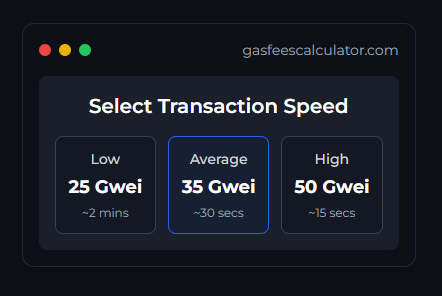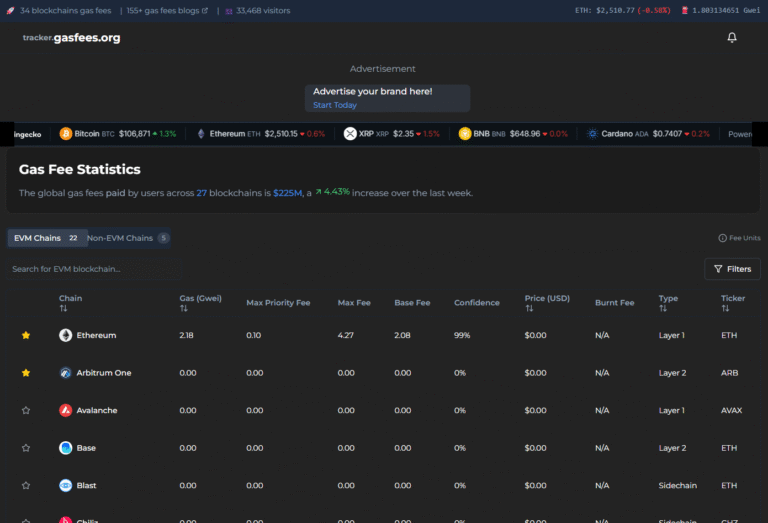
What Are Base Gas Fees?
When the Ethereum network is busy, with many transactions pending, the base gas fee increases to encourage users to pay more for faster processing, thereby managing network demand. Conversely, during quieter periods, the base gas fee decreases.
The base gas fee is part of the broader gas mechanism designed to prevent network spam and ensure that transactions are processed in an orderly manner. It is calculated based on the block size and the average of the previous block's gas used. Users can't tip below this base fee, but they can add a priority fee (or tip) on top of it to incentivize miners to include their transaction sooner. This system was introduced with Ethereum's EIP-1559 update, aiming to make transaction fees more predictable and efficient.
What is a Layer 2 (L2)? A Layer 2 (L2) solution on Ethereum refers to a secondary blockchain or protocol layer built on top of the Ethereum mainnet (Layer 1 or L1) with the primary goal of improving the scalability and efficiency of the network. Layer 2 solutions aim to address some of the limitations of Ethereum, particularly its high transaction fees and slower transaction confirmation times.
Base gas fees represent the minimal charges needed to facilitate transactions on a blockchain network. These fees are known for their cost-efficiency and adaptability since they can change according to the current state of the network.
Base operates as an Ethereum Layer 2 (L2) solution, providing the security, stability, and scalability necessary to empower on-chain applications. In this guide, we’ll explore Base gas fees, their benefits, and how Base simplifies the developer experience while fostering interoperability with other chains.
Base: An Ethereum Layer 2 Solution
Base offers the Ethereum Virtual Machine (EVM) environment at a fraction of the cost, granting early access to Ethereum features like Account Abstraction (ERC4337). It simplifies the developer experience by providing user-friendly APIs for gasless transactions and smart contract wallets. Base is built upon Optimism’s open-source OP Stack, ensuring accessibility to all and allocating a portion of sequencer revenue to fund public initiatives, contributing to the public good.
The Role of Coinbase in Base
In collaboration with Coinbase, Base offers decentralized applications (dApps) an accessible gateway to leverage Coinbase’s products and distribution network. This includes seamless integrations with Coinbase services, straightforward fiat onramps, and access to the extensive $130 billion in assets available within the Coinbase ecosystem. Base aims to be a pivotal player in bringing the next billion users into the world of blockchain, providing a secure, cost-effective, and developer-friendly solution for Ethereum L2.
Understanding Layer 2 (L2) Solutions
A Layer 2 (L2) solution on Ethereum refers to a secondary blockchain or protocol layer built on top of the Ethereum mainnet (Layer 1 or L1) with the primary goal of improving the scalability and efficiency of the network. Layer 2 solutions aim to address some of the limitations of Ethereum, particularly its high transaction fees and slower transaction confirmation times.
Base.org’s Unique Fee Model
Base.org, as an Ethereum Layer 2 (L2) scaling solution, operates on a fee model that differs from the traditional gas fee model found on the Ethereum Layer 1 (L1). In Base, the fees employ a different mechanism:
Sequencer Fees
Instead of users directly incurring gas fees for transactions, Base.org relies on a concept known as “Sequencer Fees.” Sequencers are responsible for ordering and submitting transactions on the Base network. Typically, entities can incentivize these sequencers to include users’ transactions in the next block. Users do not pay transaction fees directly to miners, as they would on Ethereum L1. Instead, sequencers receive compensation for their work through the fees associated with transaction execution.
L1 Bridge Fees
When users interact with Base.org, fees may be applicable when bridging assets from Ethereum Layer 1 to Base Layer 2 or vice versa. These bridge fees are typically paid in the native cryptocurrency of the respective chain (e.g., Ether for Ethereum L1). Users bear the responsibility for covering these fees when moving assets between the two layers.
Staying Informed with Base
Base.org continues to develop and refine its protocol. Users should always refer to the latest information and documentation provided by Base.org’s official documentation to stay informed about the platform’s features, updates, and fee structures.
Conclusion
Base gas fees and its Ethereum Layer 2 (L2) solution offer a promising alternative to traditional gas fees on Ethereum Layer 1. With a unique fee model and a focus on cost-efficiency, Base simplifies the developer experience while fostering interoperability and collaboration with platforms like Coinbase. As blockchain technology continues to evolve, solutions like Base will play a vital role in expanding the reach of decentralized applications and bringing more users into the world of blockchain and DeFi.



